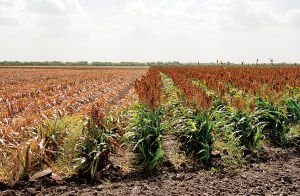
HARLINGEN — Vernon Swanberg expects a much better sorghum crop this year.
It has to be better than last year when neither he nor many other farmers had a crop at all because of the lack of rain.
“This year we do have a pretty fair sorghum crop out there if nothing happens to it,” said Swanberg, a retired adviser for Swanberg Family Farms near Raymondville.
Brad Cowan, county extension agent, agreed, but is hesitant to make an absolute prediction.
“Farmers are really reluctant to say what’s going to happen in the future,” he said. “The crops are still at risk while it’s in the field.”
But he added that it appears this year will be an above average sorghum crop.
“We had a severe drought last year, and it caused a widespread crop failure even in grain sorghum, which is our most drought-resistant crop,” he said. “We’re talking about a better-than-average crop (this year), and it all goes down to the kind of rainfall we were receiving in the winter time prior to planning and then getting some moisture during the season.”
Andy Scott, director of research at Rio Farms, Inc. in Monte Alto, said that last year there was a period of 103 days of no rain, and that period went right into the heart of the growing season in March and April. Grain sorghum, he said, is usually planted in mid-February.
Meteorologist Mike Castillo, at the National Weather Service in Brownsville, said that between June 19, 2012 and June 19, 2013, Harlingen received 11.96 inches of rain; Brownsville 20.90 inches of rain; and McAllen had 9.52 inches. In the same period from 2013 to 2014, Harlingen received 29.79 inches of rain, Brownsville got 27.96 inches, and McAllen 17.09 inches.
Cowan said the Rio Grande Valley had a wet fall that started in late August and lasted through November. The winter was also wet, and then it rained a couple of times this spring. This was a sharp contrast to what the Valley has received in recent years.
Ted Prukop, Valley Ag Crop Insurance manager for Texas Citrus Mutual, said some areas of the Valley had a good crop in 2012, but Willacy County was left out. The last time the entire region had a good sorghum crop was in 2010.
Sam Sparks, partner and owner of SRS Farms in Mercedes, said the sorghum crop looks excellent, and noted the rainfall.
He said cooler temperatures delayed planting, but once the soil warmed to 60 degrees, they were able to plant with an abundance of moisture still in the ground.
Sparks said SRS plants almost 1,000 acres of sorghum south of Harlingen, with about 3,000 acres in the Mercedes and Santa Rosa area. The entire business farms 10,000 acres of sorghum, cotton, corn and sugarcane, he said.
While some sorghum farmers, he said, didn’t have a crop at all last year, he was able to do some planting. But, because of the drought and the lack of irrigation water, he had to leave 45 percent of the acreage unplanted. The ground he was able to plant produced a decent crop, he said. Overall, however, he described it as a “substantial loss.”
Although there was ample rain this year, SRS still had to leave 15 percent of the crop idle. That was about 1,500 acres, he said, because of the shortage of
irrigation water.
Swanberg said most of the grain in Willacy County will cut between 4,000 and 5,000 pounds an acre. Sorghum is presently selling for $7.75 to $8 per 100 pounds. He said this year’s harvest will help cover some of the losses of last year’s failed crop.
Farmers have many expenses, and it’s not unusual, he said, to spend $75 an acre on fertilizer, and then there are pesticides and other expenses.
Fortunately, last year he like many farmers had insurance that helped cover some of the losses.
There was one scare this year when the sugarcane aphid began attacking the Valley’s sorghum crop.
“It affected it quite a bit,” Cowan said. “A lot of acres were treated, but the treatments were, for the most part, successful, and it protected the crop from that insect. Some of the fields that didn’t get sprayed are a total loss.”
Sparks said SRS Farms started harvesting its sorghum on Wednesday, with about 20 days to complete the harvest.
Prukop, the Valley Ag Crop Insurance manager, conceded that the harvest is starting a little late because of the cool, wet spring.
“It’s getting hot and dry fast,” Prukop said. “Some of that grain is burning up because it was kind of spoon-fed the rain, but the crop is good. And now it’s a matter of getting it out of the field and into the grain tanks.”

